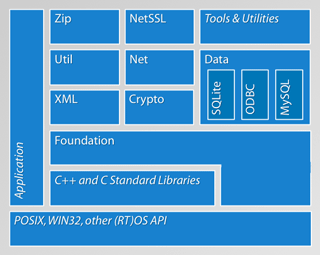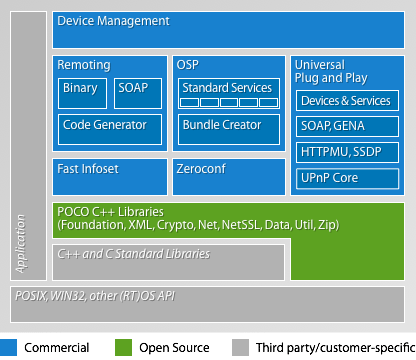POCO C++ Libraries提供一套 C++ 的类库用以开发基于网络的可移植的应用程序,功能涉及线程、文件、流,网络协议包括:HTTP、FTP、SMTP 等,还提供 XML 的解析和 SQL 数据库的访问接口。不仅给我的工作带来极大的便利,而且设计巧妙,代码易读,注释丰富,也是非常好的学习材料,我个人非常喜欢。POCO的创始人在这个开源项目的基础上做了一些收费产品,也成立了自己的公司,"I am in the lucky position to work for my own company",真是让人羡慕啊。
POCO C++ Libraries

基于POCO的产品

Poco主页:
http://pocoproject.org/Poco文档:
http://pocoproject.org/docs/创始人主页:
http://obiltschnig.com/公司主页:
http://www.appinf.com/我主要用过Net,Data,XML部分,Net里对socket的封装类,实现TCP,HTTP,SMTP协议的框架,Data里对MySQL接口封装,XML里对DOM标准的实现。我目前主要是做C++网络编程,曾经尝试接触ACE库,但觉得太复杂难理解,而且也没有条件用于项目,后来发现了Poco,不仅简单易用,而且也包含《C++ Networking Programming》中提到的各种模式和框架,更难得的是文档注释丰富,看起源码来相当舒服。因此想写一些笔记,一方面借此加深对网络编程的理解,另一方面也希望和大家多多交流。
第一篇讨论Poco::TCPServer框架,先看看Poco::TCPServer有哪些类
 class Net_API TCPServer: public Poco::Runnable
class Net_API TCPServer: public Poco::Runnable
 class Net_API TCPServerConnection: public Poco::Runnable
class Net_API TCPServerConnection: public Poco::Runnable
 class Net_API TCPServerConnectionFactory
class Net_API TCPServerConnectionFactory
 class Net_API TCPServerDispatcher: public Poco::Runnable
class Net_API TCPServerDispatcher: public Poco::Runnable
 class Net_API TCPServerParams: public Poco::RefCountedObject
class Net_API TCPServerParams: public Poco::RefCountedObjectRunnable是一个抽象类,要求其子类实现一个run()函数,run()一般作为线程的入口函数.
先看看run函数是如何被调用的,以TCPServer为例。
 void TCPServer::start()
void TCPServer::start()


 {
{
 poco_assert (_stopped);
poco_assert (_stopped);

 _stopped = false;
_stopped = false;
 _thread.start(*this);//这里传入本类对象地址
_thread.start(*this);//这里传入本类对象地址
 }
}再看看Thread类的start函数
 class Foundation_API Thread: private ThreadImpl
class Foundation_API Thread: private ThreadImpl
 void Thread::start(Runnable& target)
void Thread::start(Runnable& target)


 {
{
 startImpl(target);
startImpl(target);
 }
}这里的ThreadImpl::startImpl是POSIX实现版本
 void ThreadImpl::startImpl(Runnable& target)
void ThreadImpl::startImpl(Runnable& target)


 {
{

 _pData->pRunnableTarget = ⌖
_pData->pRunnableTarget = ⌖
 if (pthread_create(&_pData->thread, &attributes, runnableEntry, this))
if (pthread_create(&_pData->thread, &attributes, runnableEntry, this))


 {
{
 _pData->pRunnableTarget = 0;
_pData->pRunnableTarget = 0;
 throw SystemException("cannot start thread");
throw SystemException("cannot start thread");
 }
}

pRunnableTarget就指向Runnable了
 void* ThreadImpl::runnableEntry(void* pThread)
void* ThreadImpl::runnableEntry(void* pThread)


 {
{

 ThreadImpl* pThreadImpl = reinterpret_cast<ThreadImpl*>(pThread);
ThreadImpl* pThreadImpl = reinterpret_cast<ThreadImpl*>(pThread);
 AutoPtr<ThreadData> pData = pThreadImpl->_pData;
AutoPtr<ThreadData> pData = pThreadImpl->_pData;
 try
try


 {
{
 pData->pRunnableTarget->run();//在这里
pData->pRunnableTarget->run();//在这里
 }
}
 catch (Exception& exc)
catch (Exception& exc)

知道run()是如何被调用了,再看看TcpServer::run()的实现
1 void TCPServer::run()
void TCPServer::run()
2

 {
{
3 while (!_stopped)
while (!_stopped)
4

 {
{
5 Poco::Timespan timeout(250000);
Poco::Timespan timeout(250000);
6 if (_socket.poll(timeout, Socket::SELECT_READ))
if (_socket.poll(timeout, Socket::SELECT_READ))
7

 {
{
8 try
try
9

 {
{
10 StreamSocket ss = _socket.acceptConnection();
StreamSocket ss = _socket.acceptConnection();
11 // enabe nodelay per default: OSX really needs that
// enabe nodelay per default: OSX really needs that
12 ss.setNoDelay(true);
ss.setNoDelay(true);
13 _pDispatcher->enqueue(ss);
_pDispatcher->enqueue(ss);
14 }
}
15 catch (Poco::Exception& exc)
catch (Poco::Exception& exc)
16


在第6行调用标准select函数,准备好读后,第10行调用标准accept建立连接,然后把StreamSocke对象放入TCPServerDispatcher对象内的队列中,可见TCPServer只是建立连接,之后的工作就都交给TCPServerDispatcher了。
在讲TCPServerDispatcher之前,先需要说明的是第10行TCPServer的_socket成员变量类型是ServerSocket,ServerSocket在一个构造函数中调用了bind和listen,具体如下
 ServerSocket::ServerSocket(Poco::UInt16 port, int backlog): Socket(new ServerSocketImpl)
ServerSocket::ServerSocket(Poco::UInt16 port, int backlog): Socket(new ServerSocketImpl)


 {
{
 IPAddress wildcardAddr;
IPAddress wildcardAddr;
 SocketAddress address(wildcardAddr, port);
SocketAddress address(wildcardAddr, port);
 impl()->bind(address, true);
impl()->bind(address, true);
 impl()->listen(backlog);
impl()->listen(backlog);
 }
}
要注意,尽管ServerSocket类提供了无参构造函数,但使用无参构造函数创建的对象,在TCPServer对象调用start()之前,必须先bind和listen。
" /// Before start() is called, the ServerSocket passed to
/// TCPServer must have been bound and put into listening state."
继续看TCPServerDispatcher,沿着TcpServer::run()第13行,我们看它的equeue()
1 void TCPServerDispatcher::enqueue(const StreamSocket& socket)
void TCPServerDispatcher::enqueue(const StreamSocket& socket)
2

 {
{
3 FastMutex::ScopedLock lock(_mutex);
FastMutex::ScopedLock lock(_mutex);
4
5 if (_queue.size() < _pParams->getMaxQueued())
if (_queue.size() < _pParams->getMaxQueued())
6

 {
{
7 _queue.enqueueNotification(new TCPConnectionNotification(socket));
_queue.enqueueNotification(new TCPConnectionNotification(socket));
8 if (!_queue.hasIdleThreads() && _currentThreads < _pParams->getMaxThreads())
if (!_queue.hasIdleThreads() && _currentThreads < _pParams->getMaxThreads())
9

 {
{
10 try
try
11

 {
{
12 static const std::string threadName("TCPServerConnection");
static const std::string threadName("TCPServerConnection");
13 _threadPool.start(*this, threadName);
_threadPool.start(*this, threadName);
14 ++_currentThreads;
++_currentThreads;
15 }
}
16 catch (Poco::Exception&)
catch (Poco::Exception&)
17


第7行enqueueNotification把一个TCPConnectionNotification入队,第13行把this交给ThreadPool启动一个线程,那么这个线程就要运行TCPServerDispatcher的run函数了,看TCPServerDispatcher::run()
1 void TCPServerDispatcher::run()
void TCPServerDispatcher::run()
2

 {
{
3 AutoPtr<TCPServerDispatcher> guard(this, true); // ensure object stays alive
AutoPtr<TCPServerDispatcher> guard(this, true); // ensure object stays alive
4
5 int idleTime = (int) _pParams->getThreadIdleTime().totalMilliseconds();
int idleTime = (int) _pParams->getThreadIdleTime().totalMilliseconds();
6
7 for (;;)
for (;;)
8

 {
{
9 AutoPtr<Notification> pNf = _queue.waitDequeueNotification(idleTime);
AutoPtr<Notification> pNf = _queue.waitDequeueNotification(idleTime);
10 if (pNf)
if (pNf)
11

 {
{
12 TCPConnectionNotification* pCNf = dynamic_cast<TCPConnectionNotification*>(pNf.get());
TCPConnectionNotification* pCNf = dynamic_cast<TCPConnectionNotification*>(pNf.get());
13 if (pCNf)
if (pCNf)
14

 {
{
15 std::auto_ptr<TCPServerConnection> pConnection(_pConnectionFactory->createConnection(pCNf->socket()));
std::auto_ptr<TCPServerConnection> pConnection(_pConnectionFactory->createConnection(pCNf->socket()));
16 poco_check_ptr(pConnection.get());
poco_check_ptr(pConnection.get());
17 beginConnection();
beginConnection();
18 pConnection->start();
pConnection->start();
19 endConnection();
endConnection();
20 }
}
21 }
}

第9行waitDequeueNotification一个Notification,第12行把这个通知类型转换成TCPConnectionNotification,联系之前的enqueueNotification,大概能才到是什么意思。第15行又出现个TCPServerConnection。好吧,看来搞清楚TCPServerDispatcher还是要先看下TCPServerConnection,还有TCPConnectionNotification。
尽管TCPServerConnection继承了Runable,但没有实现run(),它的start()如下
 void TCPServerConnection::start()
void TCPServerConnection::start()


 {
{
 try
try


 {
{
 run();
run();
 }
}


用户需要继承TCPServerConnection实现run函数,看下源码中的说明,要完成对这个socket的处理,因为run函数返回时,连接就自动关闭了。
 class Net_API TCPServerConnection: public Poco::Runnable
class Net_API TCPServerConnection: public Poco::Runnable

 /**//// The abstract base class for TCP server connections
/**//// The abstract base class for TCP server connections
 /// created by TCPServer.
/// created by TCPServer.
 ///
///
 /// Derived classes must override the run() method
/// Derived classes must override the run() method
 /// (inherited from Runnable). Furthermore, a
/// (inherited from Runnable). Furthermore, a
 /// TCPServerConnectionFactory must be provided for the subclass.
/// TCPServerConnectionFactory must be provided for the subclass.
 ///
///
 /// The run() method must perform the complete handling
/// The run() method must perform the complete handling
 /// of the client connection. As soon as the run() method
/// of the client connection. As soon as the run() method
 /// returns, the server connection object is destroyed and
/// returns, the server connection object is destroyed and
 /// the connection is automatically closed.
/// the connection is automatically closed.
 ///
///
 /// A new TCPServerConnection object will be created for
/// A new TCPServerConnection object will be created for
 /// each new client connection that is accepted by
/// each new client connection that is accepted by
 /// TCPServer.
/// TCPServer.连接在哪被关闭的呢,注释说随着TCPServerConnection对象销毁而关闭。具体就是,TCPServerConnection类有个StreamSocket成员,StreamSocket继承自Socket,Socket类又包含了个SocketImpl成员,所以就有~TCPServerConnection()->~StreamSocket()->~Socket()->~SocketImpl(),最后~SocketImpl()调用close()关闭了连接。
那么TCPServerConnection对象何时被创建何时被销毁呢,这下又回到TCPServerDispatcher::run()来了,看TCPServerDispatcher::run()的第15行,创建了TCPServerConnection对象,第18行调用TCPServerConnection::start()进而调用TCPServerConnection::run(),第20行块结束,TCPServerConnection对象随着智能指针销毁而被销毁。
还剩TCPConnectionNotification或者说Notification要搞清楚了,但是要对Poco的Notifactions模块源码进行分析的话,本文的篇幅也就太长了,就从文档来大致看看吧
Notifications
Facilities for type-safe sending and delivery of notification objects within a single thread or from one thread to another, also well suited for the implementation of notification mechanisms. A notification queue class for distributing tasks to worker threads, simplifying the implementation of multithreaded servers.
简单的说Notifications模块可用于线程间传递消息,简化多线程服务器的实现。具体到TCPServer,就是把已连接的socket,放到NotificationQueue中,并从TheadPool出来一个线程,线程从NotificationQueue取到这个socket,从而用TCPServerConnection::run()里的逻辑对socket进行处理。
至此TCPServer基本分析完毕,还有TCPServerConnectionFactory和TCPServerParams,分别用于产生TCPServerConnection和设置参数,就不细说了。
纵观Poco::TCPServer,套一下
《Unix Network Programming》里讲的服务器模型,属于“在程序启动阶段创建一个线程池之后让主线程调用accept,并把每个客户连接传递给池中某个可用线程”。Poco1.3.6版里用select作为IO multiplexing。1.3.7版正在尝试epoll(windows平台依然是select),但还未release,跟踪svn来看也没有使用edge-triggered模式。套用《The C10K problem》里讲的服务器模型,属于"Serve many clients with each thread, and use nonblocking I/O and level-triggered readiness notification"。总结起来就是:non-blocking IO + IO multiplexing(level-triggered) + thread pool。
Poco::TCPServer也许并不能算一个性能很高的TCP服务器,但我非常喜欢它的设计和编码风格。顺便提一下对底层socket的封装,由socket类派生的各种子类,ServerSocket在构造函数中进行bind和listen,StreamSocket在构造函数进行connect,都是非常贴心的设计。
下一篇打算分析Poco的Reator框架。